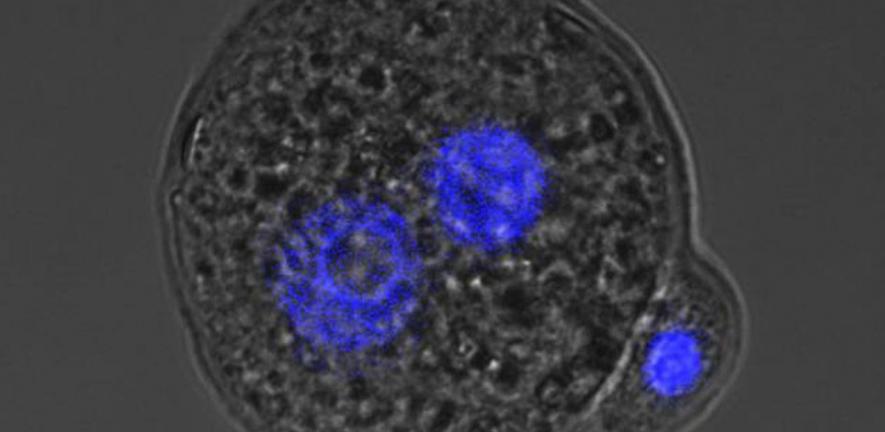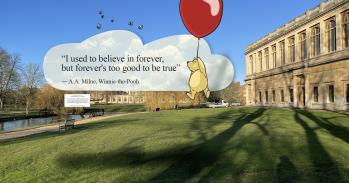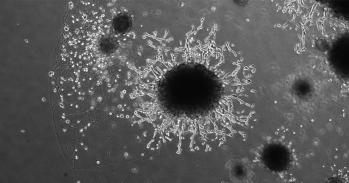
In the first report of our Egg Cetera series on egg-related research, biologists Dr Harry Leitch and Professor Azim Surani describe how advances in understanding egg development could transform reproductive and regenerative medicine.
In the first report of our Egg Cetera series on egg-related research, biologists Dr Harry Leitch and Professor Azim Surani describe how advances in understanding egg development could transform reproductive and regenerative medicine.
When an adult body cell, like a nerve cell or a blood cell, is introduced into an egg, even if the egg’s own genetic material has been removed its remaining factors have the capacity to reset the developmental clock and erase all the attributes of the matured cell.
The egg is the largest and one of the most complex cells produced by living organisms. It is also immortal. According to physiologist Jacques Loeb (1913), “the fertilised egg… lives indefinitely, in as much as it gives rise, not only to a new individual, but, theoretically at least, to an endless series of generations”. Precisely how the egg develops into a whole new organism has long fascinated scientists.
In some organisms, the egg has all the information to develop into an adult. Indeed, ‘virgin birth’ or parthenogenesis has been observed in animals such as frogs, lizards and even recently in sharks. As fertilisation does not occur in these cases, there is no contribution from the paternal DNA normally provided by the sperm. Instead the egg finds a way to maintain two copies of maternal DNA. Once this is achieved, everything the egg needs for full development is found within it and, as it matures, these factors initiate the developmental programme by instructing the genetic blueprint to express the right genes at the correct time and place.
Normally, however, development proceeds following fertilisation of the egg by sperm, bringing DNA from each parent together. Understanding the remarkable sequence of events that unfolds – and especially an erasing and reprogramming step that happens to the DNA during this process – is one focus of our research at the Wellcome Trust/Cancer Research UK Gurdon Institute.
Many decades ago, scientists discovered that the egg’s factors have an extraordinary property. When an adult body cell, like a nerve cell or a blood cell, is introduced into an egg, even if the egg’s own genetic material has been removed its remaining factors have the capacity to reset the developmental clock and erase all the attributes of the matured cell. This reconstituted egg – now containing the genetic information of a different individual – acquires the ability to develop into a new organism. Such cloned animals from adult body cells were first obtained in frogs and were famously used to create Dolly the sheep.
How, then, given all the unique attributes exhibited by an egg, is the potential for parthenogenetic development curtailed in mammals, including humans? Our research has shown that the answer is not connected with the factors present inside the egg, but with the instructions that are marked on the genetic material.
Maternal and paternal genetic material at fertilisation carries specific imprints, rather like molecular flags on the DNA, inherited from each of the two parents. The imprints don’t alter the genetic content of the parental contributions, but influence the expression of some vital genes. Essentially, this parental imprinting means that only by combining DNA from both parents at fertilisation can expression of all the necessary genes for full development occur appropriately.
More recent advances in stem cell research are beginning to pave the way towards the generation of cells that go on to become mammalian eggs and sperm – the primordial germ cells. Stem cells either made from early embryos, or following reprogramming of adult body cells, can be converted into primordial germ cells, and potentially and ultimately into eggs and sperm. A major boundary to this will be the appropriate resetting of the parental imprints. Recent work in our lab has characterised an erasure process which happens during formation of germ cells that wipes out all the pre-existing imprints. This leaves the genetic information ready for new imprints to be laid down – a process that occurs during development of the eggs and sperm in the growing fetus.
Reproducing these steps in the culture dish will be a major challenge in the years to come. Advances in the mechanisms of resetting the information carried on DNA can be widely applied to manipulating stem cells and for erasing inappropriate information from diseased tissues. It also raises the prospect that sperm and eggs could be developed directly from body cells in a culture dish. Not only does such research help us to understand the incredible story of the developing egg but it’s an important new research frontier for reproductive medicine and the treatment of infertility, as well as for regenerative medicine in general.
Dr Harry Leitch and Professor Azim Surani
Azim Surani leads a research group at the Wellcome Trust/Cancer Research UK Gurdon Institute that investigates all aspects of early germ cell development and aims to discover how any cell could be converted into the precursors of eggs and sperm. Harry Leitch is an MB/PhD student, currently working with Azim as a research associate. Azim is a Professorial Fellow of King’s College and his research is funded by the Wellcome Trust
This work is licensed under a Creative Commons Licence. If you use this content on your site please link back to this page.





